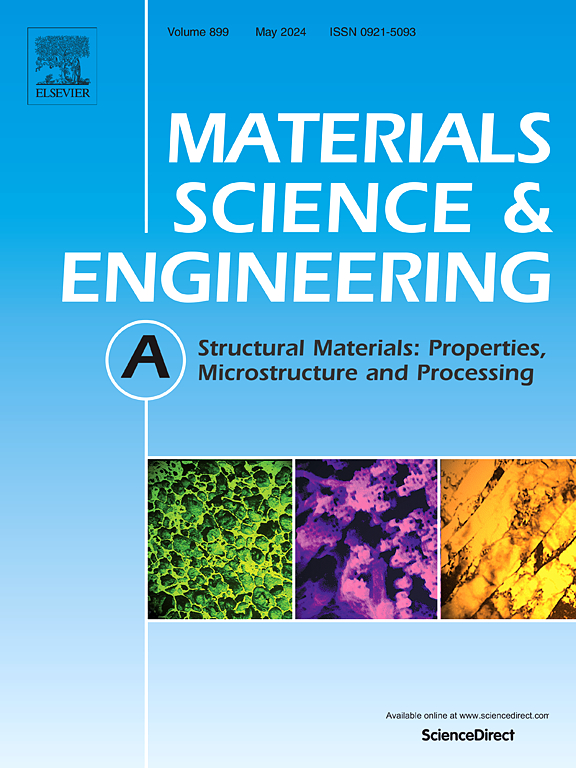95W-3.5Ni-1.5Fe钨重合金的粘结剂喷射增材制造:增强延展性和动态变形机制
IF 6.1
2区 材料科学
Q1 MATERIALS SCIENCE, MULTIDISCIPLINARY
引用次数: 0
摘要
本研究通过粘结剂喷射3D打印技术(BJ3DP)制备了95W-3.5Ni-1.5Fe钨重合金(WHAs),优化了工艺参数(层厚= 50 μm,粘结剂饱和度= 75%)和专有的水基粘结剂配方。经过一系列的加工,包括印刷、固化、脱脂和烧结,合金表现出了典型的两相微观结构,并达到了接近全密度(99.9%)。与传统粉末冶金制备的合金相比,BJ3DP制备的合金在保持中等屈服强度和极限抗拉强度的同时,延展性明显增强。断口分析表明,钨颗粒与γ相界面结合的改善主要是由颗粒滑移和裂纹桥接机制引起的。此外,动态冲击试验揭示了不同加载条件下的应变硬化行为:应变率低于2000 s−1时,位错滑移引起的均匀塑性变形占主导地位,而应变率高于2000 s−1时,热激活促进钨颗粒内部的快速位错重排和湮灭,导致变形区形成板状亚晶粒。这种动态恢复过程有效地减轻了应变硬化,并通过局部剪切变形促进了应力的重新分布,从而有助于合金具有优异的延展性。这些发现验证了应用工艺粘合剂优化策略的有效性,为增材制造重钨合金的变形机制提供了关键见解,并为先进工程应用的高性能材料的设计和优化提供了一条有希望的途径。本文章由计算机程序翻译,如有差异,请以英文原文为准。
Binder jetting additive manufacturing of a 95W-3.5Ni-1.5Fe tungsten heavy alloy: Enhanced ductility and dynamic deformation mechanisms
This study demonstrates the fabrication of 95W-3.5Ni-1.5Fe tungsten heavy alloys (WHAs) via binder jetting 3D printing (BJ3DP) with optimized process parameters (layer thickness = 50 μm, binder saturation = 75 %) and a proprietary water-based binder formulation. After sequential processing—including printing, curing, debinding, and sintering—the alloy exhibited a characteristic two‐phase microstructure and achieved near‐full density (99.9 %). Compared with WHAs produced via conventional powder metallurgy, the BJ3DP‐fabricated alloy demonstrated markedly enhanced ductility while maintaining moderate yield and ultimate tensile strengths. Fractographic analysis revealed that improved interfacial bonding between tungsten particles and the γ-phase arises primarily from mechanisms of particle slip and crack bridging. Moreover, dynamic impact tests elucidated the strain-hardening behavior under varied loading conditions: at strain rates below 2000 s−1, uniform plastic deformation via dislocation slip dominated, whereas at strain rates above 2000 s−1, thermal activation promoted rapid dislocation rearrangement and annihilation within tungsten particles, leading to the formation of plate-like subgrains in the deformation zone. This dynamic recovery process effectively mitigates strain hardening and facilitates stress redistribution via localized shear deformation, thereby contributing to the alloy's superior ductility. These findings validate the effectiveness of the applied process-binder optimization strategy, providing critical insights into the deformation mechanisms of additively manufactured tungsten heavy alloys and offer a promising pathway for the design and optimization of high-performance materials for advanced engineering applications.
求助全文
通过发布文献求助,成功后即可免费获取论文全文。
去求助
来源期刊

Materials Science and Engineering: A
工程技术-材料科学:综合
CiteScore
11.50
自引率
15.60%
发文量
1811
审稿时长
31 days
期刊介绍:
Materials Science and Engineering A provides an international medium for the publication of theoretical and experimental studies related to the load-bearing capacity of materials as influenced by their basic properties, processing history, microstructure and operating environment. Appropriate submissions to Materials Science and Engineering A should include scientific and/or engineering factors which affect the microstructure - strength relationships of materials and report the changes to mechanical behavior.
 求助内容:
求助内容: 应助结果提醒方式:
应助结果提醒方式:


